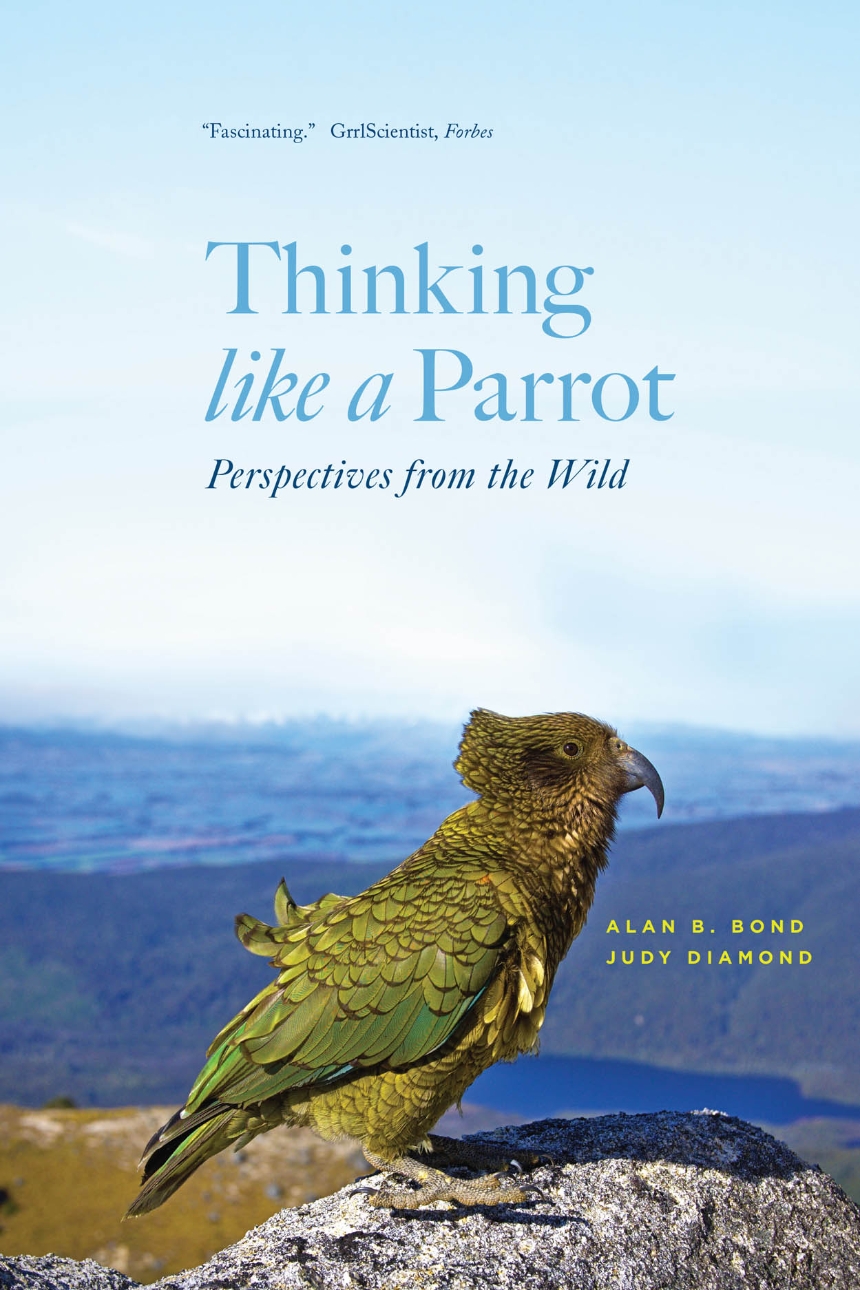Thinking like a Parrot
Perspectives from the Wild
From two experts on wild parrot cognition, a close look at the intelligence, social behavior, and conservation of these widely threatened birds.
People form enduring emotional bonds with other animal species, such as dogs, cats, and horses. For the most part, these are domesticated animals, with one notable exception: many people form close and supportive relationships with parrots, even though these amusing and curious birds remain thoroughly wild creatures. What enables this unique group of animals to form social bonds with people, and what does this mean for their survival?
In Thinking like a Parrot, Alan B. Bond and Judy Diamond look beyond much of the standard work on captive parrots to the mischievous, inquisitive, and astonishingly vocal parrots of the wild. Focusing on the psychology and ecology of wild parrots, Bond and Diamond document their distinctive social behavior, sophisticated cognition, and extraordinary vocal abilities. Also included are short vignettes—field notes on the natural history and behavior of both rare and widely distributed species, from the neotropical crimson-fronted parakeet to New Zealand’s flightless, ground-dwelling kākāpō. This composite approach makes clear that the behavior of captive parrots is grounded in the birds’ wild ecology and evolution, revealing that parrots’ ability to bond with people is an evolutionary accident, a by-product of the intense sociality and flexible behavior that characterize their lives.
Despite their adaptability and intelligence, however, nearly all large parrot species are rare, threatened, or endangered. To successfully manage and restore these wild populations, Bond and Diamond argue, we must develop a fuller understanding of their biology and the complex set of ecological and behavioral traits that has led to their vulnerability. Spanning the global distribution of parrot species, Thinking like a Parrot is rich with surprising insights into parrot intelligence, flexibility, and—even in the face of threats—resilience.
People form enduring emotional bonds with other animal species, such as dogs, cats, and horses. For the most part, these are domesticated animals, with one notable exception: many people form close and supportive relationships with parrots, even though these amusing and curious birds remain thoroughly wild creatures. What enables this unique group of animals to form social bonds with people, and what does this mean for their survival?
In Thinking like a Parrot, Alan B. Bond and Judy Diamond look beyond much of the standard work on captive parrots to the mischievous, inquisitive, and astonishingly vocal parrots of the wild. Focusing on the psychology and ecology of wild parrots, Bond and Diamond document their distinctive social behavior, sophisticated cognition, and extraordinary vocal abilities. Also included are short vignettes—field notes on the natural history and behavior of both rare and widely distributed species, from the neotropical crimson-fronted parakeet to New Zealand’s flightless, ground-dwelling kākāpō. This composite approach makes clear that the behavior of captive parrots is grounded in the birds’ wild ecology and evolution, revealing that parrots’ ability to bond with people is an evolutionary accident, a by-product of the intense sociality and flexible behavior that characterize their lives.
Despite their adaptability and intelligence, however, nearly all large parrot species are rare, threatened, or endangered. To successfully manage and restore these wild populations, Bond and Diamond argue, we must develop a fuller understanding of their biology and the complex set of ecological and behavioral traits that has led to their vulnerability. Spanning the global distribution of parrot species, Thinking like a Parrot is rich with surprising insights into parrot intelligence, flexibility, and—even in the face of threats—resilience.
296 pages | 20 color plates, 35 halftones, 6 line drawings | 6 x 9 | © 2019
Biological Sciences: Behavioral Biology
Reviews
Table of Contents
Preface
Part One: Origins
1. Rainbow Lorikeet
2. Evolution
3. Brain and Sensory Systems
Part Two: Behavior
4. Sulphur-Crested Cockatoo
5. Expression and Response
6. Play
Part Three: Sociality
7. Crimson-Fronted Parakeet
8. Relationships
9. Vocal Communication
Part Four: Cognition
10. Kākā
11. Cognition in the Wild
12. Intelligence
Part Five: Disruption
13. Rose-Ringed Parakeet
14. Expansion
Part Six: Conservation
15. Kākāpo
16. Contraction and Collapse
Part Seven: Parrots and People
17. Captain Flint Meets Polynesia
Part One: Origins
1. Rainbow Lorikeet
2. Evolution
3. Brain and Sensory Systems
Part Two: Behavior
4. Sulphur-Crested Cockatoo
5. Expression and Response
6. Play
Part Three: Sociality
7. Crimson-Fronted Parakeet
8. Relationships
9. Vocal Communication
Part Four: Cognition
10. Kākā
11. Cognition in the Wild
12. Intelligence
Part Five: Disruption
13. Rose-Ringed Parakeet
14. Expansion
Part Six: Conservation
15. Kākāpo
16. Contraction and Collapse
Part Seven: Parrots and People
17. Captain Flint Meets Polynesia
Acknowledgments
Appendix A. Common and Scientific Names of Parrot Species Mentioned in the Text
Appendix B. Analysis Methods for Brain Volume and Body Mass in Parrots and Corvids
Appendix C. Comparisons of Form and Frequency of Play Behavior in Keas, Kākās, and Kākāpōs
Appendix D. Kea Social Network Analysis
Appendix E. Kea Vocalizations
Appendix F. Kākā Vocalizations and Dialect Methods
Appendix G. Conservation Status of Parrot Species Mentioned in the Text
Notes
References
Index
Appendix A. Common and Scientific Names of Parrot Species Mentioned in the Text
Appendix B. Analysis Methods for Brain Volume and Body Mass in Parrots and Corvids
Appendix C. Comparisons of Form and Frequency of Play Behavior in Keas, Kākās, and Kākāpōs
Appendix D. Kea Social Network Analysis
Appendix E. Kea Vocalizations
Appendix F. Kākā Vocalizations and Dialect Methods
Appendix G. Conservation Status of Parrot Species Mentioned in the Text
Notes
References
Index
